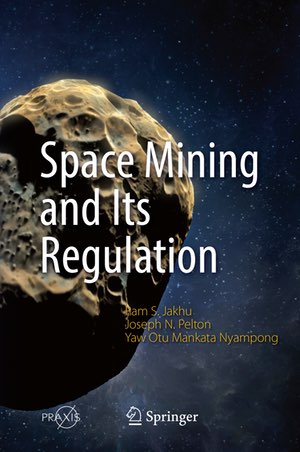Review: Space Mining and Its Regulationby Jeff Foust
|
| The authors conclude “it may be difficult and complex to draw a line between legitimate ‘use’ and the prohibited ‘appropriation by use’ of outer space and its natural resources.” |
A new book examines this growing interest in at least the potential development of lunar and asteroid resource extraction as a viable business. Space Mining and Its Regulation is by three space law and policy experts based in Canada, the United States, and Ethiopia. While the book is intended to be, as the authors write in the preface, a “one-stop shopping” reference to the emerging field, its title and the authors’ backgrounds correctly suggest an emphasis on legal and regulatory issues that have already created some controversy.
The initial chapters of the book attempt to discuss some of the scientific and technical issues associated with space mining, such as the types of resources available and the technologies needed to extract them. They also review some of the government and private efforts in the US and other nations, such as planetary missions being undertaken by national space agencies and discussions of space resource startups. This is all done at a very high level, and sometimes the information doesn’t seem very relevant to the subject: for example, they recount the history of robotic missions by space agencies to Mars and Venus, two worlds not considered leading destinations for space resource extraction ventures.
The authors are on firmer ground when it comes to the legal issues of space mining, in particular how it might conflict with existing treaties. They go into considerable detail examining the relevant treaties, including the widely-adopted Outer Space Treaty and less-accepted Moon Treaty, as well as the space resource language in the CSLCA. While the International Institute of Space Law issued a statement shortly after the CSLCA’s enactment that concluded that the law was consistent with the Outer Space Treaty, the authors are more skeptical of that interpretation, concluding that “it may be difficult and complex to draw a line between legitimate ‘use’ and the prohibited ‘appropriation by use’ of outer space and its natural resources.”
They also, in something of a contrarian argument, attempt to make a case for the Moon Treaty (or Moon Agreement, as they refer to the accord in the book) as a better legal structure for space mining. The treaty’s language calling celestial bodies the “common heritage of mankind” turned off many people to the agreement, and thus major spacefaring nations have not ratified it. The authors argue instead that, unlike the Outer Space Treaty and its uncertain interpretations regarding space resource utilization, the Moon Treaty provides a clear approach for how countries and organizations can exploit space resources under an “international regime” established under the treaty. “It is unfortunate that some States and many space law writers often mistakenly overplay the importance of the concept of common heritage of mankind,” they write.
The authors don’t discuss, though, other provisions of the Moon Treaty that give pause to would-be signatories. The international regime that the treaty would create is assigned several responsibilities, including the “equitable sharing by all States Parties in the benefits derived from those resources, whereby the interests and needs of the developing countries, as well as the efforts of those countries which have contributed either directly or indirectly to the exploration of the moon, shall be given special consideration.” Concerns about the implications of “equitable sharing” have turned off countries to the treaty for decades, with little evidence of any change of opinion in recent years as interest about space mining grows.
| Despite Luxembourg’s SpaceResources.lu effort, which includes not just the new law but plans to invest as much as 200 million euros into the emerging field, there’s virtually no discussion of those plans in the book. |
While Space Mining and Its Regulation offers an interesting assessment of the state of space resource utilization and its legal issues in particular, it suffers from poor editing. There are inconsistencies throughout the book: it refers to both “SpaceX” and, inaccurately, “Space X”; it also uses “X Prize,” “X-Prize,” and “XPrize” interchangeably (the prize organization, a bit quixotically, prefers the all-caps, no-space “XPRIZE.”) The sentence at the end of a section on ion propulsion includes an editorial comment: “Considerable progress has been made in the United States, Russia, Europe, (Unfinished sentence?)” Yes, indeed.
A bigger, more curious oversight involves Luxembourg, the country most active in the space resources field other than the United States. Despite the country’s SpaceResources.lu effort, which includes not just the new law but plans to invest as much as 200 million euros into the emerging field, there’s virtually no discussion of those plans in the book. Only in one paragraph near the end of the book do the authors mention pending legislation in Luxembourg, while also mentioning potential efforts in the United Arab Emirates as well. Books do have long publication timeframes, so it’s understandable that the latest developments aren’t included. However, the Luxembourg government had been signaling its interest in the topic for some time, making its omission particularly odd.
That Space Mining and Its Regulation doesn’t capture all of the developments in space mining is hardly surprising; it is really closer to being the first word, rather than the last word, on the topic. Its strength is its analysis of the legal issues of space mining, particularly taking arguments that are outside of the mainstream of thinking on the topic. Finding international consensus on those issues may be as critical as the financial and technical challenges space mining faces: after all, it doesn’t matter how great your technology is in extracting water ice or precious metals if there’s no guarantee you’ll be able to make use of, and profit from, those resources.
